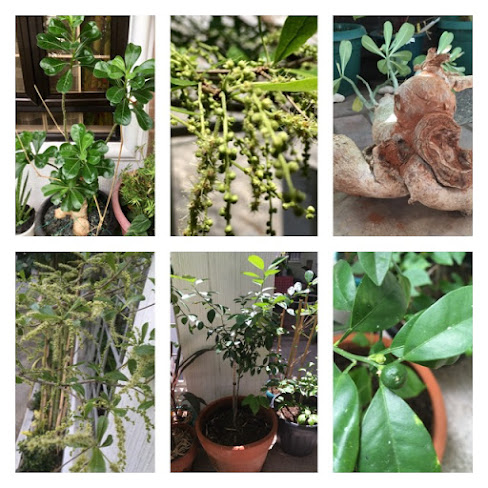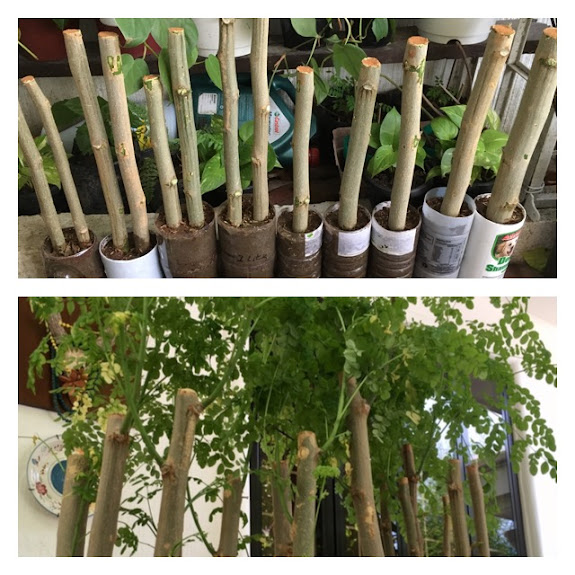HOME-MADE MALUNGGAY/ MORINGA POWDER: A Boost for Your Plants and More
Have you tried using Malunggay/ Moringa powder to nourish your plants?
Much has been written and proven about the power of Malunggay (Moringa) in providing health benefits to people - from being a source of essential vitamins and minerals needed by the body to the prevention and treatment of respiratory, digestive and other illnesses.
In similar ways, it can also be beneficial to plants.
FIRST HAND EXPERIENCE
My personal experience in gardening confirms that Malunggay, when converted to powder form and mixed with water can boost the growth of newly planted or repotted plants and can promote blooming and fruiting.
I tried this with the African Talisay that I marcotted which quickly developed prolific buds and blooms two weeks after it shed off leaves when it was cut from the Mother Tree.
The Kalamansi tree I planted on the ground did not show progress of growth for a year, but started to bear flowers and fruits after I moved it to a huge pot with a weekly dose of Malunggay powder.
My neighbor’s Adenium Obesum under my care did not have roots when I planted it but started to grow new leaves and flower buds after a month of weekly watering with Malunggay powder.
HOW TO MAKE MALUNGGAY POWDER
Summer is the ideal time to transform Malunggay into powder as the scorching heat of the sun can dry the leaves very quickly.
You can also do this during the rainy days when leaves grow more abundantly. However, drying may take longer and molds may grow on the leaves if moisture content is not totally removed.
Let me share with you how I do it:
🌿 Wear a hand glove and remove the stems from the branches.
🌿 Remove the leaves by sliding your fingers through the stems.
🌿 Spread the leaves about an inch thick on an aluminum laundry basin and dry under the sun.
🌿 Every now and then, turn the leaves from the bottom to the top to ensure uniform drying of all leaves. Do this repeatedly for a week.
🌿 At any time when the leaves have turned crispy, mash the leaves with your hands to break them into smaller pieces. Do this everyday as you turn the leaves from the bottom to the top. This will also help reduce grinding time.
🌿 Use an ordinary grinder to pulverize the crushed leaves. Tiny stems may be included but it may require a little more grinding time.
🌿 Store the powder in dry, covered containers and scoop out with a measuring spoon. Keep the powder from getting wet while in storage.
HOW TO USE MALUNGGAY POWDER AS A GROWTH BOOSTER OR NOURISHMENT FOR YOUR PLANTS
The good thing about home-made Malunggay powder is that it does not use any chemicals in the preparation, so overdose is not an issue.
You can use it as often as you feel necessary in any amount. You can also keep a stock of it and make it immediately available for use anytime you need it without fear of spoilage even for months.
It is ideal for those who are into organic gardening, or where there is no easy access to commercial fertilizers, or simply to cut down on gardening time and fertilizer costs without sacrificing the growth quality of plants.
Here are some important learning points to remember based on my experience:
🌿 The proportion of 4 tablespoons Malunggay powder to 1 liter of water once a week can already produce good results.
🌿 It is best to use rain water but you can also use tap water. However, leave the tap water overnight in a pail to allow water treatment chemicals to settle down before mixing.
🌿 Powdered Malunggay takes a while to thoroughly mix with water through simple stirring, so using a blender can make things quicker but this is not necessary.
🌿 Slowly pour the mixture into the soil until you see traces of the mixture coming out of the pot hole. You may see some unmelted grains but this should not be a concern as they will eventually incorporate with the soil.
🌿 Do not water for 24 hours to avoid washing away the nutrients.
🌿 You can also apply Malunggay powder by mixing it directly with the soil. However, mixing it with water allows the nutrients to be quickly absorbed by the roots.
Below are video demonstrations for your guide.
I prefer to use a white container when mixing the Malunggay powder with water. Just seeing the water slowly turn to green energizes me and boosts me up. Can you imagine how much boost it can give to your plants?
PROPAGATION AND OTHER USES OF MALUNGGAY
Fortunately, Malunggay thrives well in sub-tropical countries like the Philippines. It can be grown from seeds or branches and will survive anywhere even without regular watering.
As a child growing up in Tilik Bay, Lubang Island I saw how my father sharpened the ends of mature Malunggay branches like a spear and buried them as a pole to support the bamboo fence that separated the yard of our ancestral home from the seashore.
Years after, the Malunggay trees marked the area by which our yard have expanded by accretion from the sea coupled with our family’s constant efforts to dump soil, sand, rocks and other debris on land that used to be a tagwakan or wave breaker.
The trees also provided us with a regular supply of leaves for fish sinigang, pakbet, ginisang mongo, sauteed sea shells and the like.
I remember that as a nursing mother, my Mother-in-law always made sure that Malunggay was part of my daily diet which helped boost my milk production for my babies.
Aside from being a regular source of food for the table, Malunggay can also be used as a unique garden accent.
A friend posted a message on how she struggled to explain to her 8-year old son why the Malunggay and papaya trees on vacant lots in their subdivision were cut and removed by the HOA.
To appease this little man’s admirable tree-loving spirit, I suggested a ‘Malunggay Forest Challenge’ for her son by planting the small stems on tall soda bottles and displaying them in the garden within his reach for easy watering; more importantly, to salvage all the leaves and transform them into powder.
Malunggay is easier to grow than many other green, leafy vegetables. The more you cut, the more leaves and branches it will produce.
In rural and urban areas, Malunggay trees are commonly grown in backyards and idle spaces. Notwithstanding this growth pervasiveness and immediate availability, people seem to set aside its importance to daily diet, giving it less preference over other more expensive vegetables and failing to explore and maximize its other uses in unprocessed form.
Market Availability of Malunggay Powder
Commercially, Malunggay products are being offered in the market as a health supplement in powder, tablet or capsule form.
I may not be aware but I have yet to see a Malunggay product being sold as a plant nourishment or growth booster.
You can use the same procedures to prepare Malunggay powder for purposes of using it as a tea drink, salad garnishing, pizza topping or as an ingredient for vegetable and meat dishes, reducing grinding fineness to suit your requirements. Just ensure to exercise extra care and strict observance of hygiene and safety measures starting from the selection and gathering of leaves to drying until grinding and storage.
Now you have a light weight, home-made pasalubong idea for relatives and friends abroad longing to have Malunggay in their dishes, and a chemical-free growth booster for their plants within easy reach!
Try it and share with us your own Malunggay boost experience.
You can also email me at greencraftivist@gmail.com for any questions or inquiries.
Apple Bleza-Morales
About the Author:
Apple is passionately interested in community greening and beautification, organic and ornamental gardening, environment protection and preservation as well as related arts and crafts. She shares her professional, personal and travel experiences to spread knowledge and information in these areas which may not be accessible to all who are similarly interested and aims to inspire others to develop and create new ideas from her blogs.
Apple holds a Master's degree in Industrial Relations from the University of the Philippines. She held leadership roles in Human Resources during her employment with the private sector, developing and implementing HR and Organizational systems that help employees to grow their careers and employers to achieve a mutually beneficial engagement.
Photos by: Maybelle B. Morales








Thanks for the information on malunggay. We've started to plant them last year here in NZ, we'll see if it survives the temperate weather.
ReplyDelete